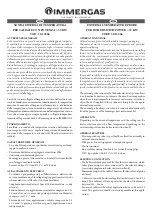
35
4) Clean the boiler flue passages as follows:
a) Remove vent connector and piping.
b) Remove barometric draft regulator.
c) Remove top jacket panel to gain access to boiler flue collector.
d) Unscrew four wing nuts and remove canopy retaining carriage bolts, lift off the canopy and ceramic fiber sealing
strips.
e) Unplug the burner, disconnect the oil lines (if the pump is hard piped), and remove the two 5/16” bolts securing the
burner door. Open the burner swing door.
f) If present, remove the flue baffles. Thoroughly brush boiler flueways from the top and diagonally between casting pin
rows. Be careful when brushing the rear passage not to damage the rear target wall insulation.
g) Vacuum soot and debris from combustion chamber.
h) Check condition of rear target wall insulation, combustion chamber liner, and burner door insulation; replace if
required.
i) Check burner head for signs of deterioration. Clean the head of any deposits.
j) Close burner door, reinstall 5/16” bolts, reconnect fuel oil and electrical lines.
k) Installation of boiler canopy, jacket top panel barometric draft regulator and breeching piping is done in reverse order
of removal. Make sure canopy is sealed tight to the casting; replace ceramic fiber sealing strips as needed. All vent
piping joints must be flue gas leak free and secured with sheet metal screws.
5) Inspect the vent system:
a) Make sure that the vent system is free of obstructions and soot.
b) Make sure that all vent system supports are intact.
c) Inspect joints for signs of condensate or flue gas leakage.
d) Inspect venting components for corrosion or other deterioration. Replace any defective vent system components.
a) Temporarily install a 1-1/4” inch or larger full port ball valve in place of the 1-1/2” plug. Temporarily pipe the outlet
of this valve to a location where hot water and steam can be safely discharged.
b) Make sure that this valve is closed and that the water level is at the normal water line.
c) If a king valve is present in the steam main takeoff, close it. Alternatively, temporarily replace enough of the
vents on the mains and/or radiators with plugs so that 2-5 psi can be developed when the boiler is fired.
d) Fire the boiler and allow it to steam until 2-5 psi is registered on the gauge.
e) Turn off the burner and immediately fully open the 1-1/4” valve.
f) Allow the boiler to blow down until either the water runs clear or the water level reaches the bottom of the gauge
glass.
g) Allow all parts of the boiler to cool to room temperature. Drain the boiler completely and remove the 1-1/4” valve.
h) If significant mud or scale is still present in the bottom of the boiler, repeat steps (b) through (g) until all mud or
scale is removed.
i) Once all mud or scale is removed, replace the 1-1/4” valve and temporary blow-down piping with the standard plug.
After all parts of the boiler are at room temperature, refill the boiler to the normal water line.
CAUTION
A large accumulation of mud or scale in the bottom of the heat exchanger is usually a sign of
excessive feedwater make-up. Such accumulations can cause severe heat exchanger damage.
If mud or scale accumulations are found:
• Make sure that all vents are in working order. Vents should not permit any passage
of steam or water.
• Check all steam and return piping for leaks. Be aware that buried return piping can
leak and go undetected during normal operation.








































